Whether deployed on-premises or in the cloud, secure email gateways (SEG) decrease phishing attacks by scanning inbound emails and their attachments for malicious payloads. Suspicious files are quarantined for administrators to scrutinize thoroughly.
Scanning outbound emails for cybercriminal content and protecting against social engineering attacks like phishing and business email compromise is how email gateway works. This is achieved by deploying various attributes within the system.
Email Encryption
Email encryption is a security measure that scrambles the content of emails, protecting them from unintended recipients (for example, hackers) who could read them. Secure email gateway solutions with email encryption capabilities enable organizations to automatically encrypt outgoing messages that contain sensitive data like financial or intellectual property. The emails are encrypted using private keys that are known only to the sender and recipient, and the encrypted messages can only be decrypted by those who have access to the private keys.
The email content is scanned for any threats, and if a message contains malware or phishing links, the email will be quarantined or blocked. Depending on the policy, the gateway may then block all communications to or from the malicious address, or it might alert the recipient that they have received a suspicious message and ask them to contact the organization directly.
Some SEGs also provide email revocation and authentication capabilities that verify recipients. These features can involve authentication tasks such as sending a one-time code to the recipient’s mobile device, asking them questions to which only they would know the answer, or checking ID documents.
Spam Filtering
Email-based attacks are among the most common cyber threats faced by organizations. Cyber attackers use emails to trick users into clicking on malicious links or downloading infected attachments that can infect their systems with malware or ransomware.
A secure gateway’s spam filtering technology scans incoming and outgoing emails to ensure they contain no malicious content. It typically employs a variety of prefiltering technologies to identify spammers’ preferred keywords and the inclusion of links that can direct users to malicious websites.
Generally, a secure gateway’s spam filters use an algorithm that gives certain phrases and words higher points than others and summarizes the scores to determine an email’s probability of being spam. This is known as heuristic filtering. It also uses behavior analysis to look for certain patterns and indicators of malicious activities.
In addition to content and behavioral analysis, a secure gateway’s spam filters may utilize machine learning to improve threat detection accuracy. This is called supervised machine learning, and it involves teaching the algorithm to recognize specific patterns or indicators of spam or phishing attempts. Using supervised machine learning to improve the spam filtering function can dramatically reduce the number of false positives that result in emails being blocked or quarantined without any reason.
Archiving
Email remains the number one method of attack for cybercriminals seeking to infiltrate systems, steal or corrupt data, and damage a company’s reputation. The best way to combat this threat is by leveraging an email security solution that enables organizations to protect their people and data by stopping them from sharing sensitive information with the wrong recipients. This is possible through a secure gateway that provides authentication and revocation capabilities to help prevent email leakage by checking whether an email recipient has been properly authenticated (via sending a code to their mobile device, questioning them on a security-related topic, or verifying ID documents) before sending them any confidential information.
To be effective, an email gateway must be able to detect and monitor both inbound and outgoing emails. An email gateway can do this by updating an organization’s MX records to route all incoming messages, just like automobile traffic goes through a law enforcement checkpoint to ensure the vehicle is not carrying contraband goods. This will also allow the SEG to scan and inspect all incoming and outgoing emails for red flags that might indicate a malicious message and filter out spam or gray mail.
Another function of an email gateway is to archive emails, ensuring that they are stored securely and quickly available should they be needed. This allows businesses to reduce the volume of data their email server manages, slashing storage requirements and potentially saving on costs and running expenses. This also helps companies comply with regulatory mandates by allowing them to keep emails within a certain legal time frame.
Continuity
Email continuity is a feature that allows businesses to maintain communication with customers and employees during times of server outages or disruptions. Without this functionality, organizations can experience a loss of productivity and potential reputational damage.
A secure gateway (SEG) is a gatekeeper for all email traffic. As emails enter the network, a gateway scans each for phishing links and malicious content, blocking them from leaving the server.
It uses a combination of spam filtering and machine learning to protect against cyber threats, including phishing, ransomware, spoofing, denial-of-service attacks, data breaches, and more. Content analysis identifies keywords and phrases used in spam emails. In contrast, a behavioral analysis compares the reputation of senders against a list of known bad actors to block emails from those with poor credentials.
In addition, many SEGs offer email archiving capabilities that safely store all email correspondence for compliance and data management purposes. Additionally, SEGs offer scalability for organizations experiencing rapid increases or decreases in email traffic or user growth.
Continuity services offer a backup email system that can be activated during server outages or other unexpected incidents, redirecting all email communication to the alternative system. This allows business communications to continue without interruption and prevents customers from waiting for their responses, which could negatively impact sales and revenue.

